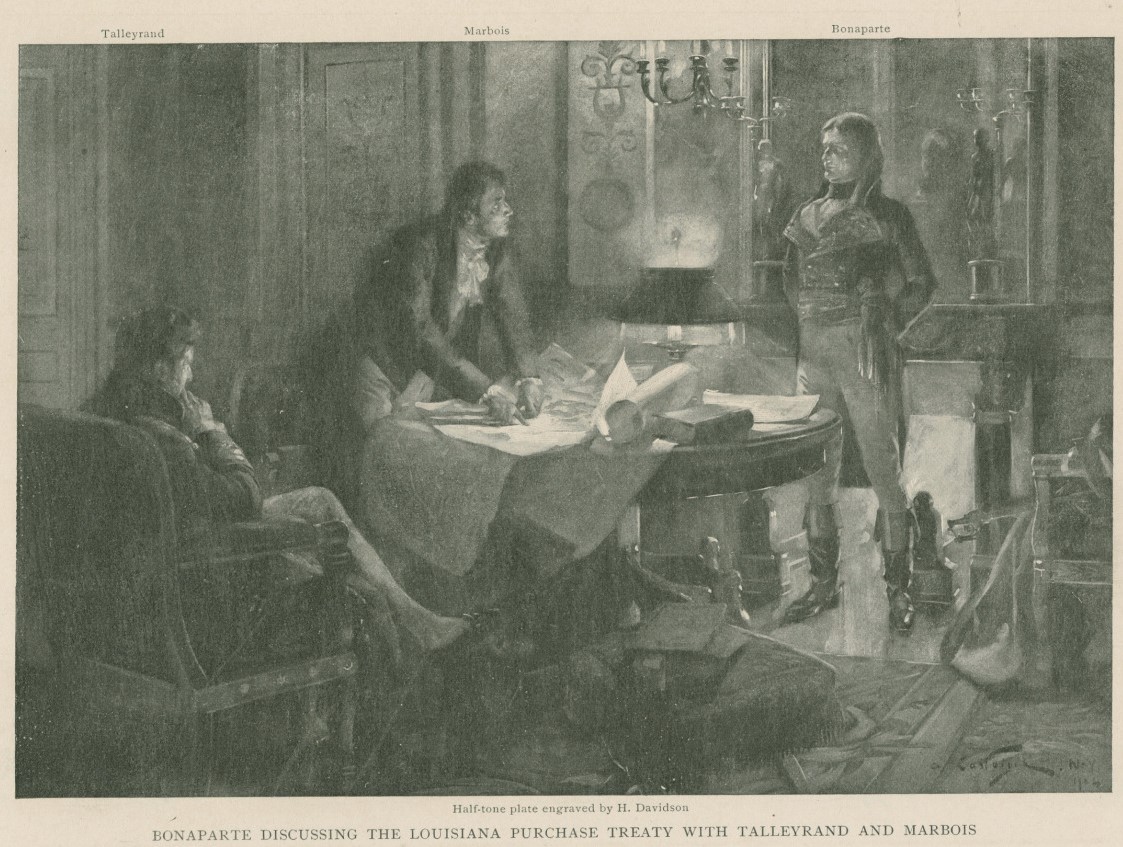Third Treaty of San Ildefonso
The Third Treaty of San Ildefonso traded the colony of Louisiana from Spain back to France and played a role in the events that led to the Louisiana Purchase.
This entry is 6th Grade level View Full Entry

The Historic New Orleans Collection
Bonaparte Discussing the Louisiana Purchase Treaty with Talleyrand and Marbois, Andre Castaigne (artist) and H. Davidson (engraver).
In the Third Treaty of San Ildefonso, Spain secretly traded the colony of Louisiana back to France on October 1, 1800. Despite the treaty, the French did not send an official representative to the colony until November 1803, the month prior to the Louisiana Purchase. In return for New Orleans and the vast territory west of the Mississippi, Spain received an Italian kingdom for the Spanish queen’s family. By transferring the colony of Louisiana back to France, the treaty played a major role in events leading to the Louisiana Purchase in 1803.
What influenced Spain’s decision to return Louisiana to France?
When Spain acquired the territory from France in the 1762 Treaty of Fontainebleau, Louisiana served as a buffer between British North America and Spain’s prized colony of Mexico. Almost four decades later, most of the land outside of New Orleans remained sparsely populated by colonists, and Louisiana’s eastern neighbor had formed into the United States. The geographic and economic expansion of the United States put Spanish territory at risk. Louisiana officials nervously watched as a growing number of Anglo-Americans moved west of the Appalachian Mountains, desperate to use the Mississippi River for trade.
By 1800 Spain’s participation in multiple wars left the kingdom drained of funds. Although the Spanish Crown hesitated to return Louisiana to an increasingly powerful France, the transfer of the colony eased Spain’s financial problems and offered better protection for Mexico. Spain also received a written pledge that France would not sell or trade Louisiana to another nation.
Why did Napoleon Bonaparte want France to regain control of Louisiana?
Regaining French control of Louisiana was part of the larger, more ambitious plans of Napoleon Bonaparte, who came to power in 1799 following the chaos of the French Revolution and the Reign of Terror in France.
Bonaparte imagined a renewed French empire in the Caribbean and North America. Louisiana would supply food, wood, and other necessities to French islands producing sugar and coffee with enslaved labor. The French colony of Saint-Domingue (modern-day Haiti) formed the center of Bonaparte’s plan. However, Saint-Domingue had been engulfed in revolution since 1791, beginning with a major insurrection by enslaved people. By 1800 slavery had been abolished and revolutionary leader Toussaint L’Ouverture governed the colony. Threatened by L’Ouverture’s authority on the island, Bonaparte sent forty thousand soldiers and sailors under the command of his brother-in-law General Charles Leclerc to regain control of Saint-Domingue in 1802. Although the French captured L’Ouverture, Black rebel troops ultimately defeated the French army. Following the loss of Saint-Domingue, Bonaparte decided to sell the entire territory of Louisiana to the United States.
How did the United States government react to the treaty?
By 1801 rumors of the Treaty of San Ildefonso reached the United States. President Thomas Jefferson and his administration considered the possible effects of the treaty on the United States. Access to the Mississippi River and the right of deposit in New Orleans was critical for Americans, especially for otherwise isolated citizens living west of the Appalachians. In 1795 the United States gained permission from Spain to ship goods downriver and export them from New Orleans. France could take away that privilege—a loss that the Jefferson administration believed could threaten the union. If the US government proved unable to maintain Americans’ right to navigate the Mississippi, the western states could break away and form their own nation. With this fear in mind, President Jefferson began a campaign to purchase New Orleans from France in 1802.
